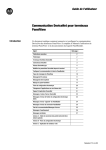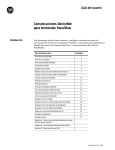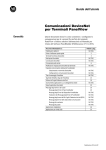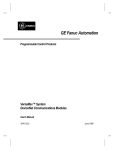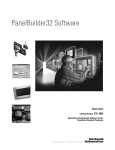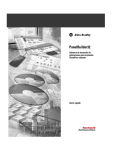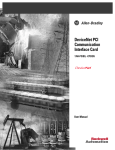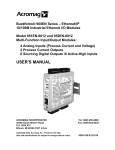Download 2711-6.0.4, DeviceNet User Guide
Transcript
User Guide DeviceNet Communications for PanelView Terminals Introduction This document describes how to connect and configure communications for the DeviceNet versions of the PanelView terminals. This information is a supplement to the PanelView Terminal user manual and the PanelBuilder software documentation. For information about: See page: Related Publications 2 Before You use this Guide 2 DeviceNet PanelView Terminals 3 Making DeviceNet Connections 3 Typical DeviceNet Network 4 Modifying DeviceNet Settings from the Terminal 5 Setting Up Communications using PanelBuilder 7 PanelView Message Types 10 I/O Slave Messaging 11 Explicit Messaging 13 PanelView Tag Form 17 Using the Electronic Data Sheet 20 Downloading Applications Over a Serial Link 21 DeviceNet Application Report 21 DeviceNet Error Messages and Codes‘ 22 Electronic Data Sheet (EDS) File Error Messages 24 PanelBuilder Device Error Messages 24 PanelBuilder Translation Error Messages 25 Communication Status/Error Messages 25 Alert Messages 26 Fault Messages 27 Appendix A - Read/Write Tag Conversion Table (Explicit Client) Appendix B - Electronic Data Sheet Appendix C - 1305 Drive Application Publication 2711-6.0.4 2 Related Publications The following documentation provides additional information about installing, configuring and using your PanelView terminals. Publication Title Publication No. PanelBuilder Software Manual 2711-6.0 PanelView Operator Terminals User Manual 2711-6.1 For more information on DeviceNet related products, refer to: Before You Use this Guide Publication Title Publication No. DeviceNet Communication Link Overview DN-2.5 DeviceNet Cable System Planning and Installation Manual 1485-6.7.1 DeviceNet Scanner (Catalog No. 1747-SDN) Configuration Manual 1747-6.5.2 DeviceNet Scanner (Catalog No. 1771-SDN) Configuration Manual 1771-6.5.118 DeviceNet Manager Software (Catalog No. 1787-MGR) User Manual 1771-2.29 RSNetworx Software (Catalog No. 9357-DNETL) User Manual 9399-DNETGR We assume that you are familiar with DeviceNet communications. This document provides a sample DeviceNet application: Appendix C - PanelView to a 1305 Drive Application. Use this application as a guide in developing your DeviceNet applications. In addition, a demo application is installed with PanelBuilder that demonstrates a PanelView to 1747-SDN (DeviceNet scanner) configuration. The demonstration files include the PanelView application file, SLC ladder logic and 1747-SDN configuration using DeviceNet Manager software. Refer to the ODVA and Allen-Bradley websites below for more examples. The Open DeviceNet Vendor Association (ODVA) has an Internet page that describes DeviceNet and provides a list of products available with electronic data sheets at: www.ODVA.org Additional network descriptions and application information are available at the Allen-Bradley website: www.ab.com At the Allen-Bradley website, refer to both the Network descriptions under Products and Services and the Rockwell Automation Technical Support pages. The technical support pages contain DeviceNet demo examples that are helpful if you are just getting started. Refer to the glossary of this document for definitions of unfamiliar terms. Publication 2711-6.0.4 3 DeviceNet PanelView Terminals DeviceNet terminals have a 10 at the end of their catalog number, for example 2711-K9A10. DeviceNet terminals have • DeviceNet communications port • RS-232 port Making DeviceNet Connections Use one of the cables below to connect the DeviceNet version of the PanelView terminal to a DeviceNet network. Cable Catalog No. DeviceNet Cable, 50 meters (164 feet) 1485C-P1A50 DeviceNet Cable, 100 meters (328 feet) 1485C-P1A150 DeviceNet Cable, 150 meters (492 feet) 1485C-P1A300 Important: Refer to DeviceNet Cable System Planning and Installation manual (Publication 1485-6.7.1) for network layout and design information. DeviceNet Connector The DeviceNet connector is identified by the label on the PanelView terminal. PanelView 900 shown 5 1 DeviceNet Port DeviceNet Terminal Block Terminal Signal Function Color 1 COM Common Black 2 CAN_L Signal Low Blue 3 SHIELD Shield Uninsulated 4 CAN_H Signal High White 5 VDC+ Power Supply Red 1 5 The typical DeviceNet current draw is 90 mA at 24V per terminal. Publication 2711-6.0.4 4 Typical DeviceNet Network Below is a typical network with PanelView terminals installed on two of the drops. PLC-5 SLC 5/04 or DeviceNet Scanner Module (Catalog No. 1747-SDN) DeviceNet Scanner Module (Catalog No. 1771-SDN) PanelView PanelView RS-232 Port DeviceNet Port DeviceNet Port Computer for developing PanelView applications 1770-KFD Module Serial Link Download/Upload SM C Smart Motor Controller RediSTATION Publication 2711-6.0.4 Drive 5 Modifying DeviceNet Settings from the Terminal You can display or modify DeviceNet settings directly from the PanelView terminal. From the terminal’s Configuration Mode menu, select Communication Setup. ! ATTENTION: Settings downloaded with a DeviceNet application have priority over terminal settings and take effect immediately after the download. PV900 Touch Screen shown other displays are similar Restart Terminal [F1] Resets the terminal. New Node Address [F2] Opens the numeric entry scratchpad. Enter the node address (0 - 63) of the PanelView terminal on the DeviceNet link and press the Enter ↵ key (on touch screen terminals, press the Enter key on the scratchpad). A node change takes effect on reset. Active Node Address Displays the current network operating address of the PanelView terminal. Default is 63. New Baud [F3] Step through baud rates with each key press: 125K (default), 250K, 500K. The selected baud rate takes effect immediately. Publication 2711-6.0.4 6 Active Baud Displays the current baud rate of the PanelView terminal. The baud rate is set to the New Baud value at power-up. The active baud is the rate of the PanelView, not the network. The PanelView is not automatically set to the network baud rate. Bus-off Interrupt [F4] Specifies what occurs when a CAN bus-off interrupt occurs on the DeviceNet network. • Hold in Reset holds the PanelView and waits for a communications reset or a terminal reset. The PanelView is not allowed network access when Hold in Reset is selected and a Bus-off Interrupt occurs. • Reset and Continue Communications resets DeviceNet communications and attempts to re-establish the communications link. Interscan Delay [F5] Provides a delay between scans of the Explicit-Client tags. The numeric entry scratchpad.Enter a value of 0 to 65535 milliseconds. This time delay is inserted between each full scan of the ExplicitClient tags in the current screen context. The value is initially set by the downloaded application but can be changed by an operator. When changed, the new value takes effect immediately. Input Size Displays the number of words (0 to 64) sent by the PanelView in an I/ O message. 0 is the default value which indicates that no input data is exchanged with the scanner. This value is set by the downloaded application. Output Size Displays the number of words (0 to 64) received by the PanelView in an I/O message. 0 is the default value which indicates that no output data is exchanged with the scanner. This value is set by the downloaded application. Comm LED • solid fill - normal operating state • blinking - no communications established • no fill - hardware failure Exit [F10] or [F16] Returns to the Configuration Mode menu. Publication 2711-6.0.4 7 Setting up Communications using PanelBuilder Setting up DeviceNet communications for an application requires: • selecting a DeviceNet terminal when creating the application. • configuring communication parameters for the terminal on the DeviceNet link. Selecting a DeviceNet PanelView Terminal Select a DeviceNet terminal for a PanelView application from: • New Application dialog when creating a new application or • Terminal Setup dialog when converting an application initially created for another terminal. Any catalog number ending with 10 is a DeviceNet terminal. Publication 2711-6.0.4 8 Configuring DeviceNet Communications DeviceNet communication parameters are accessed from the Terminal Setup dialog. To open the Terminal Setup dialog, select Application>Terminal Setup. 1. Click the Comms. Setup button from the Terminal Setup dialog. 2. Under Terminal, edit the following parameters. Specify To: Node Address Select the address (0 to 63) of the PanelView terminal on the DeviceNet link. Baud Rate Select the baud rate of the DeviceNet link. The available baud rates are 125 kbps, 250 kbps, 500 kbps. 3. Under I/O Scanner, edit the following parameters: Publication 2711-6.0.4 Specify To: Input Size Specify the number of words (0 to 64) that are sent to the scanner from the PanelView with each I/O message. 0 is the default value which indicates that no input I/O data exists in the application. Size must match configuration in Master device. Output Size Specify the number of words (0 to 64) that are received by the PanelView from the scanner with each I/O message. 0 is the default value which indicates that no output I/O data exists in the application. Size must match configuration in Master device. 9 4. Edit the following parameters: Specify To: Interscan Delay Provide a delay between scans of the Explicit-Client tags. Enter a value of 0 to 65535 milliseconds. The default is 500 msec. This time delay is inserted between each full scan of Explicit-Client tags in the current screen context. Note: Time delays of less than 500 msec should be carefully considered since the Explicitly-Client mode will generate low priority network messaging at this interval. Bus-off Interrupt 5. Specify what occurs when a Bus-off Interrupt occurs on the network: • Hold in Reset holds the PanelView and waits for communications to be reset. • Reset and Continue Communications resets DeviceNet communications and attempts to re-establish the communications link (if possible). Click OK to exit and return to the Terminal Setup dialog. Publication 2711-6.0.4 10 PanelView Message Types All PanelBuilder screen control or display objects are assigned a tag when an application is developed. The tag defines an address, data type, initial value, and other parameters for the data assigned to the object. The Tag Editor has 3 dialogs for DeviceNet objects, depending on the message type selected: • I/O Slave • Explicit Server • Explicit Client. All three message types can exist and run simultaneously within a single PanelBuilder application. Publication 2711-6.0.4 11 I/O Slave Messaging The I/O slave message connections use the pre-defined Master/Slave connection set. Exchanged data is grouped in Assembly Instances created using the PanelBuilder Tag Editor. The first input instance and the first output instance are exchanged using DeviceNet I/O slave messages. The PanelView supports a maximum of 64 input and 64 output words. The number of words exchanged is determined by the Communication Setup dialog in PanelBuilder and the Master (scanner) device DeviceNet configuration. Data at the PanelView tag addresses can be mapped to any location in the DeviceNet scanner but must be a continuous block of 1- 64 input or output words. Change-of-State, Cyclic and Polled I/O modes are supported. Strobed I/O messaging is not supported by the PanelView. DeviceNet PanelView terminals support the following types of I/O messaging when configured in the DeviceNet scanner. Polling The DeviceNet scanner initiates communications with the PanelView terminal by sending a Polled Request. The PanelView responds to the request by providing the requested data. Data is sent by the PanelView at intervals determined by the ladder logic program and/or the Interscan Delay of the scanner (not the PanelView Interscan Delay setting). Change of State (COS) The DeviceNet scanner establishes the connection with the PanelView terminal. The exchange of data is Asynchronous. Output data is sent to the PanelView from the scanner only when the data changes. The PanelView terminal sends Input data back to the scanner only when the data changes. Acknowledged/Unacknowledged modes are available (see ‘Notes’ on the next page). Cyclic Data is exchanged between the PanelView terminal and scanner at the Heartbeat Rate. The Heartbeat Rate is set using a DeviceNet Manager tool, such as RSNetwork for DeviceNet, during network setup. Publication 2711-6.0.4 12 I/O Slave Data Exchange The following diagram shows how data is exchanged using I/O messaging: I/O Slave Tags PV Address I:0 Input Tag Assembly Instance 1 Input Tag I/O M essag I:63 Output Tag Output Tag e Res p o ns e Master Device (Scanner) O:0 Assembly Instance 2 Output Tag O:63 u I/O Req sage est Mes PanelView I/O Slave Messaging Notes and Recommendations Publication 2711-6.0.4 • The I/O size specified in the PanelView terminal (“Configuring DeviceNet Communications” on page 8) must match the I/O size expected by the DeviceNet scanner. • COS, Polled and Cyclic are selected during configuration of the scanner. You do not have to configure the PanelView to accept COS, polled and cyclic messages. • Both acknowledged and unacknowledged Change-of-State / Cyclic modes are allowed. We recommend that you use the acknowledged COS mode since the device sending the message never knows that data was received when unacknowledged COS is used. • If acknowledged mode is used, no data is returned in the acknowledgment. • The Polled + COS option is allowed but the polled response data and the COS data are from the same assembly. For the most efficient operation, do not use the Polled + COS option. • Use of COS or Cyclic I/O connections is highly recommended over Polled I/O for I/O sizes in excess of 32 words (to minimize network traffic). • I/O messages have higher priority than Explicit messaging. 13 Explicit Messaging The PanelView with DeviceNet can communicate with other DeviceNet products that have Unconnected Message Manager (UCMM) capability. The PanelView can function as either a: • Client - where the PanelView initiates the exchange of data with a server. • Server - where the PanelView responds to data request from a client. UCMM data transfers are referred to as either Explicit Client or Explicit Server and are configured in the PanelView tag form dialog. For more information on specific DeviceNet commands and functions, contact the Open DeviceNet Vendors Association (ODVA). Explicit Server With Explicit Server messaging, the PanelView terminal (Server) controls the data and waits for client device(s) to request or send data. Assembly Instances 3-16 contain the PanelView data with up to 64 words in each instance (total of 896 words can be transferred). Inputs and outputs cannot be placed in the same instance. Only Get_Attribute_Single and Set_Attribute_Single commands are supported. For PanelView objects with Explicit Server addressing: • Get_Attribute_Single (service code 0xOE) External client device reads the PanelView objects (tags). • Set_Attribute_Single (service code 0x10) External client device sends values to the PanelView output objects (tags). The following illustrates explicit server messaging functions: Explicit-Server Message Tags For Inputs: Client device initiates communications with Explicit ‘GET’ Message to obtain input data from the PanelView (server). The PanelView (server) responds by sending data. For Outputs: Client device sends data using an Explicit ‘SET’ Message to set output data. The PanelView (server) responds that data has been received. Explicit ‘GET’ Message Input Tag Input Tag Assembly Instance 3-16 PanelV iew R espond s Input Tag Output Tag Assembly Instance 3-16 Output Tag iew PanelV it ‘SET Explic d Respon ’ or ‘G E s Client Device (Scanner, PC, ...) ssage T’ M e PanelView Publication 2711-6.0.4 14 Notes on using Explicit Server Messages • Explicit Server messages have a lower priority than I/O slave messages. Publication 2711-6.0.4 • Client devices access input/output data from the value attribute (attribute 3) of the assembly object class (class code 4) using the specified tag instance number (instance 3-16). • The PanelView has only one general purpose Explicit message connection available at a time to an external client device. Remember this when creating applications that require multiple Explicit message server connections. • Data from one client device can overwrite the data sent by another client. 15 Explicit Client The PanelView can also communicate using peer-to-peer Explicit-Client messaging, where the PanelView (Client) initiates the connections and obtains data from other devices (Server). Connections to other devices are created with Tag Form addresses and use explicit messages to read and write values to other DeviceNet nodes. PanelView Explicit-Client communications only support transactions with UCMM capable network devices. Only Get_Attribute_Single and Set_Attribute_Single commands are supported. For PanelView objects with explicit client addressing: • Get_Attribute_Single (server code 0xOE) The PanelView sequentially scans values addressed to PanelView objects in the current screen (or global objects) and reads data from the external server device. • Set_Attribute_Single (server code 0x10) The PanelView sends values to the external device when a change of state is detected on that input. Output data is acquired similar to polling and input data is sent on Change of State (COS). The location of the data in the DeviceNet Server device must be specified in the PanelView data tags. Data locations on the server device are specified by providing the Node Address, Class, Instance, Attribute and the Byte/Bit Offset. The Class, Instance and Attribute are provided in the user documentation of the device the PanelView is communicating with. Refer to Appendix A for the Packet Bytes and Offsets required for read and write tags. The following illustrates how Explicit-Client messaging functions: Explicit-Client Message Tags For Read tags: PanelView (client) device initiates communications with Explicit ‘GET’ Message to obtain input data from the server device. The server device responds by sending data. For Write tags: PanelView (client) device sends data using an Explicit ‘SET’ Message to set output data. The server device responds that data has been received. Write Tag Write Tag Write Tag Read Tag Message Explicit ‘SET’ onse Server Resp Server Device 1 (Sensor, Drive, ...) age ess ’M ET G ‘ e t lici ons esp Exp R ver Ser Server Device 2 (Sensor, Drive, ...) Read Tag Read Tag Write Tag Server Device (Sensor, Drive, ...) PanelView Publication 2711-6.0.4 16 Notes on using Explicit Client Messaging Do not use the Explicit Client messaging with critical control parameters or as an alternative to a hard-wired emergency stop button. ATTENTION: ! Publication 2711-6.0.4 • Devices must have a sufficient number of available connections to support an Explicit Message connection by the PanelView and any other connections required by the application. This includes a Group 2 Only Slave owned by a Group 2 Only Client such as a scanner that can proxy the UCMM service for the slave. • Data read/written must be accessible as an externally addressed DeviceNet attribute with the Get_Attribute_Single and Set_Attribute_Single commands. • Explicit-Client messaging is not designed for high speed communications and uses lower priority messaging on DeviceNet. Use I/O messaging for time critical applications. • PanelBuilder Version 2.40 and later allows you to use an offset for writing multiple words in each instance. The PanelView reads or writes an entire Assembly Instance. The Packet Bytes and Bit Offset in the tag address filter the requested information. • The PanelView can access 128 unique Explicit-Client tags (unique Node, Class, Instance, Attribute). 17 PanelView Tag Form Use the Tag Form to enter DeviceNet tags. Do not use the Table View since it does not show all of the DeviceNet fields. Refer to the PanelBuilder documentation for information for any fields not described on the following pages. . I/O Slave Tag Explicit Server Tag Read/Write tags cannot be in the same instance. Explicit Client Tag Refer to Appendix A for Read/ Write Tag Conversion Tables Obtain from the documentation of the device being read or written. Node Address of the device (server) the PanelView is communicating with. Publication 2711-6.0.4 18 Field Publication 2711-6.0.4 Description Valid Characters Notes Tag Name Name of tag Maximum characters=32 • A-Z, a-z, 0-9 • hyphen (-), underscore (_), percent(%) • if you type an invalid character, the Tag Editor beeps and does not display it • tag name must be unique within a project • cannot begin with 0-9, hyphen (-), or percent (%) • tag names are not case-sensitive • do not use blanks, tabs, carriage returns, nonprintable characters Data Type Data format of tag Select one of the following: • bit (Bool) • 4BCD (16 bits) • unsigned integer (16 bits) • signed integer (16 bits) • IEEE float (32 bits) • bit array (size varies) • character array (8 bits/char.) The data type must be compatible with the data format selected in the object’s dialog. Alternate Methods: Type the first letter of the data type. For example, type b for bit data type. Use the TAB key to move to the Data Type filed and press ALT+↓ to display the list of available formats. Swap Bytes Displayed when Character Array data type selected. Check Box • when selected high and low data bytes swap positions. Select swap bytes when data is sent in the wrong order (high byte first). For example, data from a PLC is sent with the 1st character of a string in the 2nd byte. By swapping the bytes, the 1st character is sent in the 1st byte. • Byte swapping is not generally used with Explicit-Client messaging. These addressed devices usually conform to DeviceNet specifications and send data in the correct sequence. Swap Words Displayed when Float data type selected. Check Box • when selected high and low words of a floating point value are swapped. This allows floating point values generated by a PLC to be properly displayed. • word swapping is not generally used for DeviceNet devices that generate floating point values. Message Type The message type. Instance Number (Explicit-Server Message Only) Instance Number from 3 to 16. 3 to 16 Node Address (Explicit-Client Message Only) Node address of peer device. 0 to 63 Load from EDS (Explicit-Client Message only) Loads information using the electronic data sheet. Write Tag (Explicit-Client Message only) Write tag data sent to server device. Check box If Write Tag is not selected, tag is specified as a read tag (data is read from server device). Packet Bytes (Explicit-Client Message only) Number of bytes in each message packet. 1 to 128 This value must match the amount of data in the attribute addressed in the external server device. Refer to appendix A. Additional fields are required for Explicit message types. Instances 1 and 2 are automatically assigned to I/O message types. Load parameter data from the data sheet for the peer device. Otherwise, enter the tag information (class, instance, attribute) from the sheet manually. 19 Field Description Valid Characters Notes Bit Offset (Explicit-Client Message only) The offset index into the returned data. Typically 0. Bit Offset is limited to the number of bytes specified for the Packet Bytes. For example, if Packet Bytes is 2, the Bit Offset must be 0 - 15. Refer to Appendix A. Class (Explicit-Client Message only) Class of the object being addressed Load information from the electronic data sheet (EDS) automatically, if possible, or refer to the target devices user documentation. Instance (Explicit-Client Message only) Instance of the object being addressed Load this information from the electronic data sheet (EDS), if possible, or refer to the target devices user documentation. Attribute (Explicit-Client Message only) Attribute of the object being addressed. Load this information from the electronic data sheet (EDS), if possible, or refer to the target devices user documentation. Array Size Size of the array • character arrays are 1- 128 characters • bit arrays are 1 - 16 bits • array size must be an integer • do not use blanks, tabs, carriage returns, nonprintable characters Description Description of tag • maximum characters =255 • type information in this field or use the description editor Address (I/O Slave and Explicit-Server Messages only) Data sent to and from remote device. A remote address has the following format: I:<word> / <bit> O: <word> / <bit> • maximum characters = 32 • I specifies input data generated by PanelView and sent to a remote device. • O specifies output data received by PanelView from a remote device. Do not use blanks, tabs, carriage returns, nonprintable characters. Initial Value Starting value for the current tag in engineering units (only for write tags) • • • • • do not use blanks, tabs, carriage returns, nonprintable characters • maximum precision is 6 places to the right of the decimal for non-floating point values • if present, a sign (+ or -) for the number must be first (+ is the default) • if present, a sign for the exponent must immediately follow the e or E • provides a preset value for numeric entry objects only • no entry = default of 0 Scaling Scale: ‘m’ in y = mx + b Offset: ‘b’ in y = mx + b The values you use to convert the current tag’s processor integer value (‘x’) to engineering units (‘y’) • maximum characters = 12 • 0-9 • e, E, +, - and period • do not use blanks, tabs, carriage returns, nonprintable characters • maximum precision is 6 places to the right of the decimal • maximum precision for offset is 6 places to the right of decimal • if present, a sign (+ or -) for the number must be first (+ is the default) • if present, a sign for the exponent must immediately follow the e or E Data Entry Limits Minimum Maximum The minimum and maximum values that can be assigned to the tag • maximum characters = 12 • 0-9 • e, E, +, -, period • do not use blanks, tabs, carriage returns, nonprintable characters • maximum precision is 6 places to the right of the decimal • if present, a sign (+ or -) for the number must be first (+ is the default) • if present, a sign for the exponent must immediately follow the e or E maximum characters = 24 0 -9 e, E, +, - and period if Data Type is bit, enter 0 or 1 Publication 2711-6.0.4 20 Using the Electronic Data Sheet Each device on the DeviceNet network has an Electronic Data Sheet (EDS) containing operating parameters of the device. Load these data sheets when using Explicit Client messaging (PanelView client accesses data from server device). Refer to the device’s user manual for instructions on obtaining the EDS file. The EDS parameters can be uploaded to the PanelBuilder Tag Form. When the Explicit-Client message type is selected in the Tag Editor, the Load From EDS option appears in the dialog. To load parameter data from the Electronic Data Sheet: 1 Click the Load From EDS button. 2. Select the EDS file you want to read. 3. After the file is loaded, the following dialog appears. When you select a group, only parameters in that group become available. By default, all parameters are displayed. 4. Select a parameter. If the parameter has bit-field enumeration associated with it, select an Enumerated Data Item. 5. Select OK to continue. 6. The class, instance, and attribute associated with the selected parameter is displayed on the tag form. Publication 2711-6.0.4 21 Downloading Applications over a Serial Link To download a DeviceNet application from your computer to the PanelView terminal over an RS-232 link: • connect computer to RS-232 port of PanelView terminal • download application from PanelBuilder Application menu. Use PanelBuilder’s internal DF1 driver for the download. This driver uses fixed DF1 settings that match those of the RS-232 port of the PanelView Terminal. Refer to the PanelBuilder software and the on-line help for details on downloading an application. DeviceNet Application Report The application printout for DeviceNet provides: • configuration data • tag data • supplemental data Publication 2711-6.0.4 22 DeviceNet Error Messages and Codes Reference # Message Recommended Action 1 Tag: <Tag Name> - Bit Offset must be a multiple of 8 for Character Arrays. Adjust the Bit Offset on the Tag Form. 2 Tag: <Tag Name> - Cannot be converted to current protocol format. Manually edit the tag to the DeviceNet protocol. 3 Tag: <Tag Name> - Data Type implies Packet Bytes should be less than or equal to 2. Certain PanelBuilder controls, however, may require additional bytes. Most PanelBuilder controls write only 1 element of data. If the associated Data Type is a Bit Array, at most 2 bytes will be written by the tag. However, if tags are assigned to the Block Write of a Piloted Control List, the number of bytes written will be a multiple of the states displayed on the list. 4 Tag: <Tag Name> - Data Type implies Packet Bytes should be equal to 2. Certain PanelBuilder controls, however, may require additional bytes. If less than 2 bytes are required, use Bit Array. Most PanelBuilder controls write only 1 element of data. If the associated Data Type is Unsigned Integer, 2 bytes will be written by the tag. However, if tags are assigned to the Block Write of a Piloted Control List, the number of bytes written will be a multiple of the states displayed on the list. 5 Tag: <Tag Name> - Data Type implies Packet Bytes should be equal to 4. Certain PanelBuilder controls, however, may require additional bytes. Most PanelBuilder controls write only 1 element of data. If the associated Data Type is IEEE Float, 4 bytes will be written by the tag. However, if tags are assigned to the Block Write of a Piloted Control List, the number of bytes written will be a multiple of the states displayed on the list. 6 Tag: <Tag Name> - Expected Analog Tag. The Tag Address should not specify a bit number. 7 Tag: <Tag Name> - Expected Colon. I or O should be followed by: Add a colon: after the I or O. 8 Tag: <Tag Name> - Expected Discrete Tag. The Tag Address should specify a bit number. 9 Tag: <Tag Name> - Expected Input Tag. Tag Address should begin with I. Change the Tag Address to begin with I. 10 Tag: <Tag Name> - Expected Output Tag. Tag Address should begin with O. Change the Tag Address to begin with O. 11 Tag: <Tag Name> - Expected Read Tag. Uncheck the Write Tag box on the Tag Form. 12 Tag: <Tag Name> - Expected Slash / in Tag Address Add a slash and bit number to the Tag Address. 13 Tag: <Tag Name> - Expected Write Tag. Check the Write Tag box on the Tag Form. 14 Tag: <Tag Name> - Explicit Server Input and Output Tags have been assigned to the same Assembly Instance. An Assembly Instance should contain only input tags or only output tags. Place input and output tags in separate assembly instances. 15 Tag: <Tag Name> - Explicit Server Input Elements must be 0 - 63. Reduce the word offset for the associated Tag Address. 16 Tag: <Tag Name> - Explicit Server Output Elements must be 0 - 63. Reduce the word offset for the associated Tag Address. 17 Tag: <Tag Name> - Incompatible Address Change the tag address to the following format: I:<word>/,<bit> or O:<word>/<bit> where <bit> is required for Bit and Bit Array 18 Tag: <Tag Name> - Input Element Extends Beyond Input Size. The word offset in the Tag Address must be less than then the Input Size specified in the Communications Setup dialog. 19 Tag: <Tag Name> - Invalid Address Type. Address must begin with I or O. Modify the Tag Address must begin with I or O. 20 Tag: <Tag Name> - Invalid Bit Number. Bit number must be 0 -15. Change the bit number to a value between 0 and 15. 21 Tag: <Tag Name> - Invalid Bit Offset. Bit Offset must not extend beyond the packet length. Reduce the bit offset. Publication 2711-6.0.4 23 Reference # Message Recommended Action 22 Tag: <Tag Name> - Invalid Data Size. Data element extends beyond input or output size. Increase the input or output size on the terminal setup screen. 23 Tag: <Tag Name> - Invalid Element Number The Tag Address must have a numeric word offset. 24 Tag: <Tag Name> - Invalid Node Address. Node must be 0 - 63. DeviceNet node addresses must be 0 - 63. 25 Tag: <Tag Name> - Invalid Packet Length. Packet Length must be 1128 bytes. Change packet bytes to 1-128 bytes. 26 Tag: <Tag Name> - Output Element Extends Beyond Output Size. The word offset in the Tag Address must be less than then the Output Size specified in the Communications Setup dialog. 27 Tag: <Tag Name> - The length of the data extends beyond the size of the packet. If the associated tag is an I/O tag, increase either the Input or Output Size. If the associated tag is Explicit-Server, the data extends beyond the 64 word limit of the Assembly Instance. 28 Tag: <Tag Name> - The length of the data extends beyond the size of the packet. Adjust Packet Bytes to at least #. Increase the Packet Bytes assigned to the tag. 29 Tag: <Tag Name> - This tag cannot be assumed consistent or ‘atomic’. The Assembly Instance is inconsistent with previous tags in this group. Tags have been assigned to a PanelBuilder control that must be updated in the same data packet. Change the Assembly Instance so it is the same as the other members of this group. 30 Tag: <Tag Name> - This tag cannot be assumed consistent or ‘atomic’. The Peer’s Class, Instance, Attribute, or Node Address is inconsistent with previous tags in this group. Tags have been assigned to a PanelBuilder control that must be updated in the same data packet. Change the Explicit-Client message so that it references the same peer attribute as other tags assigned to this group. 31 Tag: <Tag Name> - This tag cannot be assumed consistent or ‘atomic’. The tag’s Message Type is inconsistent with the previous tags in this group. Tags have been assigned to a PanelBuilder control that must be updated in the same data packet. Change the Message Type so that it is the same as the other members of this group. Publication 2711-6.0.4 24 Electronic Data Sheet (EDS) File Error Messages Reference # Message Recommended Action 1 Could not allocate memory. The system cannot allocate enough memory to read the EDS file. 2 In order to support scaling, the PV Data Type will be changed to Unsigned Integer. The chosen parameter has scaling factors. To support scaling factors, an appropriate PV Data Type must be chosen. The scaling factor will be calculated and entered as the Scale and Offset values on the Tag Form. 3 Invalid EDS File. The EDS file is corrupt or contains too many parameters to be read. 4 The DeviceNet Data Type (#) does not match the PanelView Data Type chosen. It is recommended that either Bool or Bit Array is chosen. Boor or Bit Array is the best choice for the parameter chosen. 5 The DeviceNet Data Type (#) does not match the PanelView Data Type chosen. It is recommended that Floating Point is chosen. IEEE Float is the best choice for the parameter chosen. 6 The DeviceNet Data Type (#) does not match the PanelView Data Type chosen. It is recommended that either Signed or Unsigned Integer is chosen. Display value scaling may be necessary. Signed or Unsigned Integer is the best choice for the parameter chosen. 7 The DeviceNet Data Type (#) is unsupported by PanelView. Use of this parameter may produce unexpected results. There is no corresponding PV Data Type for the DeviceNet parameter chosen. This parameter requires knowledge of how the DeviceNet data is structured. For instance, one element of the DeviceNet Time Data Type may be displayed, but the location of the internal fields must be known. 8 This parameter designates that extended precision scaling should be used to display the parameter. PanelView does not support extended precision scaling. The chosen parameter specifies Extended Precision Scaling. The appropriate scaling factor must be manually determined and entered into the Scale and Offset fields of the Tag Form. 9 Unable to open EDS File. The system was unable to open the specified EDS file. PanelBuilder Device Error Messages Reference # Message Recommended Action 1 Device: <Device Name> - Cannot be converted to current protocol format. Create a new device entry in the Terminal Setup dialog. 2 Device: <Device Name> - Communication settings have never been initialized. Update the Communications Setup dialog to the appropriate network values (node address, baud rate). 3 Device: <Device Name> - Converted to DeviceNet. Default communication parameters will be used. Update the Communications Setup dialog to the appropriate network values (node address, baud rate). Publication 2711-6.0.4 25 PanelBuilder Translation Error Messages Message Recommended Action Too many peer accesses. Only 128 Explicit-Client message channels are allowed per application. Reduce the number of Explicit-Client Tags in your application. Translation Failure Contact Allen-Bradley for technical support. Communication Status Error Messages These errors appear as a banner at the top of an application screen (error #634 in upper left corner) or as Mod/Net LED status on the terminal’s Configuration screen. Errors codes 11 or less are minor fault conditions and clear automatically when corrected. Error codes above 11 require a terminal reset to clear the error. Code Indicates: Recommended Action 1 No connections established. Occurs on power-up until a device connection is established on the network. Establish a connection over DeviceNet to the PanelView. 2 A connection is in the timed out state. Occurs once I/O messaging is stopped after an I/O connection has been running. Check the network wiring and that the master device (scanner) is operational. 3 An Explicit-Client tag cannot be obtained. Occurs if the device associated with an Explicit-Client tag is not responding or the peer tag does not exist at the specified class, instance, and attribute number. Check the data location is correct and that the end device is attached and operational. For write tags, ensure that the appropriate attribute is targeted. If the targeted device is UCMM capable, ensure it has enough explicit message connections to allow the PanelView to take one. If the targeted device is not UCMM capable, ensure that it is owned by a Master device (scanner). 4 A zero length I/O message was received placing the I/O application in idle mode. Occurs when the scanner is in program mode. Error clears when switched back to run. Correct the problem of the Master sending the I/O idle condition. 5 Message Overrun. Message traffic from the PanelView is being generated quicker than it is possible to send the data. Occurs with large I/O sizes when Change-Of-State is being used and state changes are occurring very quickly or if polling too fast. Slow down I/O polling or the state changes generating change of state I/O messages. Use cyclic I/O at a fast heartbeat rate rather than change-of-state. Use the production inhibit capability on the master. 11 No network power detected. Occurs if network 24V is not present. Check the wiring. Message automatically clears when 24V network power is restored. 12 Dup MAC Failure. Occurs if the PanelView powers up with the same Node Address present on the network. Change the node address to an unused address and reset the terminal. 13 Bus-off Interrupt occurred. CAN Chip is held in reset. Caused by noise on network signal lines or an attempt to connect to the network at the wrong baud rate. Check baud rate and network wiring, including termination resistors. Reset the terminal. Publication 2711-6.0.4 26 Alert Messages These messages appear as a box in the middle of the screen (Error #636 in upper left of box) and alert the user to a condition. Operation of the terminal continues. Alert messages can be cleared. Code Indicates: Recommended Action 2 Unsupported DeviceNet Message received. The Network Access Object received a message that is not supported. Should not occur in normal operation. Clear the message. If problem re-occurs, contact Allen-Bradley. 3 Initial Writes Failure. The Motherboard failed to send all input data to the daughter card prior to network startup. Should not occur during normal operation. Clear the message. If problem reoccurs, contact Allen-Bradley. 4 Invalid Explicit-Client Address. Occurs at runtime if the node address associated with the Explicit-Client tag is the same as the PanelView. Clear the message and determine which tag in the application is pointing to the PanelView’s node address. Correct the application. 7 Change-Of-State Input Overrun. Occurs if PanelView state changes on I/O input data occurred faster than the PanelView could send them to the I/O scanner. Clear the message. Excessive network traffic could cause this problem if inputs are changing rapidly. 8 Identity Object Reset Service received over DeviceNet. Occurs if an external device sends an Identify Object Reset Service to the PanelView. An external network device has requested a PanelView terminal reset. Press a key to clear the alarm. 10 Unsupported DeviceNet message received. Should not occur during normal operation. Clear the message. If problem reoccurs, contact Allen-Bradley. 12 Invalid ASA Number (0x00000000 or 0xFFFFFFFF). Occurs if the flash memory is corrupt or an invalid ASA number was programmed. Clear the message. The message occurs each time the terminal is reset. The terminal operates normally but you should correct the problem. Contact Allen-Bradley. 13 Invalid Screen Context Priority received. Should not occur in normal operation. Clear the message. If problem reoccurs, contact Allen-Bradley. 14 Get Next Scan Item Failed in peer mode. Should not occur in normal operation. Clear the message. If problem reoccurs, contact Allen-Bradley. 15 Explicit-Client Input Data not received. Will occur if an input (push button) changes a second time before its previous state was sent on the network. Only for ExplicitClient Tags. Clear the message. Excessive network traffic could cause this problem if inputs are changing rapidly. Handle high speed input data over I/O connections if possible. Also make sure the addressed attribute exists and is settable on the network. Also occurs when the packet bytes do not match the number of bytes in the server’s assembly instance. Publication 2711-6.0.4 16 I/O Connection Size does not match size of I/O data in Assembly Instances 1 & 2. Programmed connection sizes for I/O do not match the amount of data represented by the I/O type tags. Clear the message and if the problem reoccurs, consult Allen-Bradley. 19 Get Next Contact Request Failure. In Explicit-Client Mode scanning, the request to obtain the next tag in current context failed. Should not occur in normal operation. Clear the message. If problem reoccurs, contact Allen-Bradley. 27 These messages indicate critical fault conditions. They appear as a full screen box with an Error #635 in the upper left corner. Reset the terminal to clear the condition. If the problem persists, note the 2digit code and contact Allen-Bradley. Fault Messages Code Indicates: Recommended Action 5 PCCC Message Transaction error during file transfer. Should not occur in normal operation. Reset the terminal. If problem re-occurs, contact Allen-Bradley. 6 Stack overflow fault. Should not occur in normal operation. Reset the terminal. If problem re-occurs, contact Allen-Bradley. 17 Client Object Failed. Should not occur in normal operation. Reset the terminal. If problem re-occurs, contact Allen-Bradley. 18 CAN Chip Failed to initialize. Should not occur in normal operation. Reset the terminal. If problem re-occurs, contact Allen-Bradley. 37 The size of a particular channel exceeds the size limitations set by the daughtercard. Should not occur in normal operation. Reset the terminal. If problem re-occurs, contact Allen-Bradley. 20xx Critical Internal DeviceNet Firmware fault. Should not occur in normal operation. Reset the terminal. If problem re-occurs, contact Allen-Bradley. 9-11 21,22 24-36 Internal faults associated with motherboard/daughtercard communications. Should not occur in normal operation. Reset the terminal. If problem re-occurs, contact Allen-Bradley. Publication 2711-6.0.4 Appendix A Read/Write Tag Conversion Table Conversion Tables (Explicit Client) Use the following tables to determine the Packet Bytes and Offset for Explicit Client messages when a server device has more than one word per Assembly Instance. The Packet Bytes and Offset determine the data location the PanelView is going to read or write. PanelView Client Read/Write Tag Conversion➀ Packet Packet Packet Word Bytes➁ Offset Word Bytes➁ Offset Word Bytes➁ Offset 0 2 0 22 46 352 44 90 704 1 4 16 23 48 368 45 92 720 2 6 32 24 50 384 46 94 736 3 8 48 25 52 400 47 96 752 4 10 64 26 54 416 48 98 768 5 12 80 27 56 432 49 100 784 6 14 96 28 58 448 50 102 800 7 16 112 29 60 464 51 104 816 8 18 128 30 62 480 52 106 832 9 20 144 31 64 496 53 108 848 10 22 160 32 66 512 54 110 864 11 24 176 33 68 528 55 112 880 12 26 192 34 70 544 56 114 896 13 28 208 35 72 560 57 116 912 14 30 224 36 74 576 58 118 922 15 32 240 37 76 592 59 120 944 16 34 256 38 78 608 60 122 960 17 36 272 39 80 624 61 124 976 18 38 288 40 82 640 62 126 992 19 40 304 41 84 656 63 128 1008 20 42 320 42 86 672 21 44 336 43 88 688 ➀ Use this conversion table with PanelBuilder 2.40 or later. ➁ For write tags, byte size depends on (and must match) the configuration of the server device. Publication 2711-6.0.4 A-2 Read/Write Tag Conversion Table PanelView to PanelView Example The following example shows how the read/write conversion table is used. In this example one PanelView functions as a server and the other PanelView acts as a client. Write Tag PanelView 1 Explicit Server Node 2 Explicit Client Messaging Read Tag PanelView 2 Explicit Client Publication 2711-6.0.4 Appendix B Electronic Data Sheet Appendix B Electronic Data Sheet All of the PanelView terminals have the following electronic data sheet (*.eds). This generic data sheet does not contain aplication specific information. $Electronic Data Sheet for PanelView $ [File] DescText=”PanelView”; CreateDate=07-25-95; Mod Date=3-22-96; Revision=1.1; [Device] VendCode ProdType ProdCode MajRev MinRev VendName ProdTypeStr Catalog = 1; $ Vendor Code = 24; $ Product Type = 1; $ Product Code = 1; $ Major Rev = 4; $ Minor Rev = “Allen-Bradley Company” = ”Human Machine Interface”; $ “PanelView” = 2711-xxxx10 Publication 2711-6.0.4 Appendix C 1305 Drive Application Using Explicit Messaging, it is possible to control certain driver parameters from a PanelView terminal without a host PC or PLC. The Allen-Bradley 1305 AC drive is connected to the 1203 DeviceNet communications module. PanelView DeviceN et Cable 1305 AC Drive 1203 Communications Module (1203-GK5) Configuring PanelBuilder Use the PanelBuilder software to create the following application screen. This screen reads and writes Accel 1 Time. A numeric entry provides the input for the acceleration time. A numeric display shows the acceleration time. Publication 2711-6.0.4 C-2 1305 Drive Application Acceleration Write Tag Configuration The following dialog configures a numeric entry object. The dialog assigns a Write Tag name and defines other attributes of the numeric entry object. Clicking the Edit Tag button allows you to edit the write tag data as shown below. The Messaging Type is defined as Explicit-Client. The Class, Instance and Attribute specify a data location in the 1305 Drive for the Accel 1 Time. Note: For more information on Class, Instance and Attribute fields, see the Bulletin 1305 Adjustable AC Drive user manual. Publication 2711-6.0.4 1305 Drive Application C-3 Acceleration Read Tag Configuration The following dialog defines a numeric display object. This dialog assigns a read tag and defines other attributes of the display object. Clicking the Edit Tag button allows you to edit the read tag data as shown below. The Messaging Type is defined as Explicit-Client. The Class, Instance and Attribute specify a data location in the 1305 Drive for the Accel 1 Time. Note: For more information on Class, Instance and Attribute fields, see the Bulletin 1305 Adjustable AC Drive user manual. Publication 2711-6.0.4 C-4 1305 Drive Application PanelView Status Screen Create the status screen below to view the drive status. Use a message display with embedded text. The dialog below defines a message display object. The dialog assigns the read tag Status to the object and defines the field width for the display object. Clicking the Edit Tag button allows you to edit the read tag data as shown below. Publication 2711-6.0.4 1305 Drive Application C-5 The Messaging Type is defined as Explicit-Client. The Class, Instance and Attribute specify a data location in the 1305 Drive for the status text. Note: For more information on Class, Instance and Attribute fields, see the Bulletin 1305 Adjustable AC Driver user manual. 1203-GK5 Communications Module Configuration Configure the 1203-Communications Module to operate with the PanelView terminal using Explicit-Client messaging. See Publication 1203-5.3 for details on how to configure the communications module. Switch 1-7 must be in the ON position (Disable Fault on Comm Loss) This setting instructs the communication module to ignore the loss of the virtual connection to the PanelView terminal. This is important since the DeviceNet PanelView terminal in the Explicit-Client mode repeatedly opens and closes the communication link used to access data. If switch 1-7 is left OFF the driver will stop whenever the PanelView closes a connection to the communications module. ! ATTENTION: When the 1203-GK5 module is set with switch 1-7 in the ON position, all DeviceNet devices (including PanelView) with Explicit connections to the drive can leave the network without any indication provided to the drive. ATTENTION: Any operation using Explicit messaging to control the operation of machinery must not be involved with system safety or of a critical nature that could potentially cause personal injury or equipment damage. Safety circuits must be hard-wired and not controlled by the PanelView terminal. Operations that are critical to safety must be under the control of a supervisory controller or computer programmed with the appropriate safety logic or programming. Download and Run the Application Validate and download the application to the PanelView terminal. The Accel 1 variable of the 1305 drive can be read or written using the control screen (screen 1). The status of the drive is displayed on the status screen (screen 2). Publication 2711-6.0.4 Glossary Assembly Object DeviceNet products usually have one or more Assembly Objects. The purpose of the Assembly Object is to group different Attributes (data) so they can be moved by a single message. See also: Instance Attribute A data element that can be read or written. Each attribute is assigned an integer value (Attribute ID) as an identifier in the range of 0-255. CAN Acronym for Controller Area Network. DeviceNet is based on CAN. CAN ID or identifier is an 11-bit field that identifies each message on any CAN network. CAN IDs must be unique. Class A set of objects that behave in a similar manner. Each object class is assigned an integer value called the Class ID (0-65535). Classes 0-99 are open, classes 100-199 are vendor specific. Higher numbers are divided between open, reserved and vendor specific, but are currently rarely used. Vendor specific classes are defined by the vendor. Client The device that originates a transmission. Applies to Explicit Messaging. With Explicit Client messaging, the PanelView terminal is the client device that requests or sends information from/to a server device. See Server. Connection The logical link between a node and one or more other nodes (for production or consumption). Most nodes have at least two connections (one explicit, one I/O). COS Acronym for Change of State. I/O messages are sent when data changes. If no change of state occurs, messages are sent at a pre-determined (heartbeat) interval. Cyclic I/O messages that are sent at a predefined fixed rate. DeviceNet DeviceNet is an open network standard based on CAN (Controller Area network). The specification and protocol are open. Vendors are not required to purchase hardware, software or licensing rights to connect devices to a system. Anyone may obtain the DeviceNet Specification from the Open DeviceNet Vendor Association, Inc. (ODVA) for a nominal reproduction charge (http://www.odva.org). Publication 2711-6.0.4 Glossary-2 DeviceNet Manager Personal computer running DeviceNet Manager software (Catalog No. 1787-MGR). This software configures DeviceNet nodes using explicit messages. Also see RSNetworx. EDS Acronym for the Electronic Data Sheet. A specially formatted ASCII file that provides information about a device’s configuration data context, content, and format. The information in an EDS allows configuration tools to provide information screens that guide a user through the steps necessary to configure a device. Explicit (Client or Server) Messages Provide multi-purpose, point-to-point communication paths between 2 devices. They provide the typical request/response-oriented network communications to perform node configuration and problem diagnosis. Explicit messages typically use low priority identifiers and contain the specific meaning of the message right in the data field. This includes the service to be performed and the specific object attribute address. They do not need to be active all the time. Identifier See CAN ID Instance An actual object such as a counter. The terms Object Instance, Object, and Instance all refer to an actual object and are often interchangeable. See also: Assembly Object and Object I/O Slave Messages I/O messages are time critical, control oriented data. They provide a dedicated, special purpose communication path between a producing application and one or more consuming applications. They are exchanged across single or multi-cast connections and typically use high priority identifiers. Unlike explicit messages, I/O messages contain only data, they do not contain any protocol in the 8-byte field. Node Address A unique number that identifies a device on a DeviceNet network. Object Each object has a defined behavior and data structure. Different objects respond differently to the same event. See Instance. Poll Messaging that involves an output message from the master to the slave. The slave responds with an input message. These messages can be of any reasonable length, including zero. Predefined Master/Slave Connection Set A simplified network scheme in which controllers (PLCs/SLCs) and computers are usually masters and the PanelView terminal is the slave. It is possible for a node to simultaneously be both master and slave (for example, the DeviceNet Scanner 17xx-SDN). The Predefined Master/Slave Connection Set includes three types of I/O connections: Poll, Strobe and COS/Cyclic. Publication 2711-6.0.4 Glossary-3 RSNetworx Network manager software (Catalog No. 9357-DNETL3). Similar to DeviceNet Manager software. Server The device that responds to a message from a client device. The Server’s response may cause it to return a message to the client. Applies to both Explicit messaging and I/O connections. With Explicit Server messaging, the PanelView terminal is the server device that responds to information requests from client devices. See Client. Strobe Messaging that involves an output message broadcast by the master to all slaves configured for this type of messaging. Each slave responds with an input message. The output message has one bit of data for each slave. The input message is from 0 to 8 bytes long. Also known as Bit-Strobe. The PanelView does not support this type of messaging. UCMM Acronym for Unconnected Message Manager. The UCMM provides for the dynamic establishment of Explicit Messaging Connections. Many simple devices do not have UCMM capabilities and may be referred to as group 2 only server devices. Publication 2711-6.0.4 Publication 2711-6.0.4 - March 1999 Supersedes Publication 2711-6.0.4 - August 1997 40061-369-01(C) 1999 Rockwell International Rights Reseved. Printed in USA







































